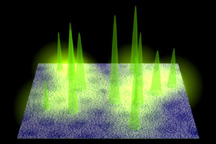Aug 12 2010
A new paper by University of Notre Dame physicist Boldizsár Jankó and colleagues offers an important new understanding of an enduring mystery in chemical physics.
 Experimentally, these quantum jumps translate to discrete interruptions of the continuous emission from single molecules, revealing a phenomenon known as fluorescent intermittency or “blinking.”
Experimentally, these quantum jumps translate to discrete interruptions of the continuous emission from single molecules, revealing a phenomenon known as fluorescent intermittency or “blinking.”
More than a century ago, at the dawn of modern quantum mechanics, the Noble Prize-winning physicist Neils Bohr predicted so-called "quantum jumps." He predicted that these jumps would be due to electrons making transitions between discrete energy levels of individual atoms and molecules. Although controversial in Bohr's time, such quantum jumps were experimentally observed, and his prediction verified, in the 1980s. More recently, with the development of single molecule imaging techniques in the early 1990s, it has been possible to observe similar jumps in individual molecules.
Experimentally, these quantum jumps translate to discrete interruptions of the continuous emission from single molecules, revealing a phenomenon known as fluorescent intermittency or "blinking."
However, while certain instances of blinking can be directly ascribed to Bohr's original quantum jumps, many more cases exist where the observed fluorescence intermittency does not follow his predictions. Specifically, in systems as diverse as fluorescent proteins, single molecules and light harvesting complexes, single organic fluorophores, and, most recently, individual inorganic nanostructures, clear deviations from Bohr's predictions occur.
As a consequence, virtually all known fluorophores, including fluorescent quantum dots, rods and wires, exhibit unexplainable episodes of intermittent blinking in their emission.
The prevailing wisdom in the field of quantum mechanics was that the on and off blinking episodes were not correlated. However, at a 2007 conference on the phenomenon sponsored by Notre Dame's Institute for Theoretical Sciences, which Jankó directs, Fernando Stefani of the University of Buenos Aires presented research suggesting that there was, in fact, correlation between these on and off events. No theoretical model available at that time was able to explain these correlations.
In a 2008 Nature Physics paper, Jankó and a group of researchers that included Notre Dame chemistry professor Ken Kuno, physics visiting assistant professor Pavel Frantsuzov and Nobel Laureate Rudolph Marcus suggested that the on- and off-time intervals of intermittent nanocrystal quantum dots follow universal power law distributions. The discovery provided Jankó and other researchers in the field with the first hints for developing a deeper insight into the physical mechanism behind the vast range of on- and off-times in the intermittency.
In a new paper appearing in the journal Nano Letters, Jankó, Frantsuzov and Notre Dame graduate student Sándor Volkán-Kascó reveal that they have developed a model for the blinking phenomena that confirms what Stefani observed experimentally. The finding is important confirmation that strong correlation exists between the on and off phenomenon.
If the blinking process could be controlled, quantum dots could, for example, provide better, more stable imaging of cancer cells; provide researcher with real-time images of a viral infection, such as HIV, within a cell; lead to the development of a new generation of brighter display screens for computers, cell phones and other electronic applications; and even improved lighting fixtures for homes and offices.
The Nano Letters paper represents another important step in understanding the origins of the blinking phenomenon and identifying ways to control the process.
Source: http://www.nd.edu/